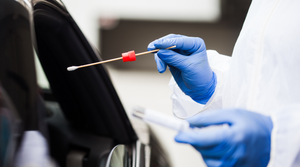Light-Cure Cyanoacrylates: An Adhesive Option for Medical Device Assembly
Originally Published MDDI June 2002ADHESIVES Catheter and infusion-device assembly are among the manufacturing processes that can be performed quickly and at low cost with the use of UVCAs.
June 1, 2002
Originally Published MDDI June 2002
ADHESIVES
Catheter and infusion-device assembly are among the manufacturing processes that can be performed quickly and at low cost with the use of UVCAs.
Christine M. Salerni
|
Both low- and high-viscosity UVCAs can be dispensed in a variety of ways. |
Introduced in 1999, ultra-violet-light-cure cyanoacrylates (UVCAs) offer medical device manufacturers an alternative to traditional adhesives. UVCAs can provide the advantages of cyanoacrylates and light-cure adhesives with few of the limitations.
The technology provides immediate surface cure when exposed to low-intensity light. It also cures in shadowed areas by reacting with surface moisture, adapts easily into production lines, and requires no second-step accelerators or activators.
UVCA OVERVIEW
UVCAs are one-part, solvent-free adhesives that fixture tack-free in seconds to form a dry, glass-like surface—even upon short-term light exposure. Quick cure times eliminate the need for accelerators, which are used with traditional cyanoacrylates to prevent blooming or frosting (the formation of a white haze or powdery residue on the bond line).
Tack-free cure is critical when adhesive is used to coat medical devices. Adhesive is applied to marker bands on catheter tubing, for example, to smooth the otherwise irregular tubing surface. A tack-free cure is also important in applications that tend to yield excess adhesive.
UVCAs also offer performance benefits for high-speed assembly processes. By curing rapidly without heat or the racking of parts, UVCAs process quickly and are reliable and easy to use. Additionally, they are deemed compliant with ISO 10993 testing protocols and such biocompatibility tests as Class VI screening evaluations (intracutaneous injection, systemic injection, and muscle implantation) and cytotoxicity and hemocompatibility tests.
Because they are based on cyanoacrylate chemistry, UVCAs offer high bond strength to a wide variety of substrates. This combination of high bond performance, complete cure, and ISO and biocompatibility compliance offers manufacturers the ability to improve the output and performance of their bonding operations.
DISPENSING AND CURING UVCAs
|
Traditional adhesives require the use of accelerators to prevent blooming. |
Currently, two variations of light-cure cyanoacrylates are commercially available: a low-viscosity (20-cP) version and a high-viscosity (900-cP) version. These two products can be dispensed in a variety of ways.
For small production quantities, for example, device manufacturers can use manual dispense methods to apply the adhesive directly from small packages onto a device. For semiautomated to fully automated production, on the other hand, device manufacturers can opt for pressure-time and positive-displacement dispense systems to ensure consistent adhesive quantities.
Regardless of production quantity, all device manufacturers must carefully consider the type and construction of their dispensers; UVCAs are cyanoacrylate based and are therefore subject to some of the same dispensation challenges as their parent technologies. Foreign materials that enter the dispense system can contribute to premature adhesive cure. And if moisture invades the dispense system, accelerated aging and curing of the adhesive can occur. Dispensing systems must also be free of extremely close-fitting components, which can trap adhesive and cause it to cure.
|
Figure 1. Cure-through depth versus time for UVCAs processed using a variety of light sources. |
UVCAs use low-intensity light sources to promote full cure, which results in a lower overall capital expenditure for the manufacturer. Figure 1 shows the cure-through depth achieved using various light sources and intensities. UVCA technology achieves depths of cure that measure well beyond traditional cyanoacrylate's gap-filling capability of ~ 0.010 in.
In bond joints that permit full light exposure, full UVCA polymerization or cure depends on the inherent gap present, but typically requires less than 30 seconds of low- or high-intensity light exposure.
The enhanced cure-through depth of UVCAs renders them suitable for such device applications as deep potting of surgical monitoring device connectors and bodies, or for filling large bond areas in fluid-collection device housings. And while UVCAs can be cured to depths of greater than 0.25 in. within 15 seconds, they will not attack plastic surfaces or contribute to stress cracking.
Typically, the fixture times for the adhesive's secondary shadow cure are substrate-dependent and can vary from seconds for such substrates as ABS and neoprene to several minutes for such materials as PVC or untreated polyolefins (polyethylene and polypropylene, for example). Full cure of the adhesive in shadowed areas requires adequate surface moisture—usually, RH levels of 40 to 60% are recommended—and approximately 24 hours of cure time.
PERFORMANCE DATA
Because of their high-strength bond to plastics, light-cure acrylics and cyanoacrylates are often used to assemble plastic disposable devices. Like their parent technologies, UVCAs provide very high-strength bonds to commonly used device plastics (see Table I).
Plastic | Approximate Shear Strength (psi) |
ABS | 5000 |
Polycarbonate | 4000 |
PVC | 4800 |
Polypropylene (untreated) | 60 |
Polyethylene (untreated) | 60 |
Table I. Five Common plastics and their respective shear strengths. |
Unlike typical light-curing acrylics, UVCAs react positively to specialty primers developed to enhance bond strength on such difficult-to-bond plastics as polyolefins and fluoropolymers. These primers are often used in a variety of medical device applications involving tubing, components, and housings. Priming polyolefin substrates and fluoropolymers usually results in a minimum increase in shear strength of 100% over that of untreated substrates. Similarly, UVCAs offer superior bond strength to neoprene and other elastomers.
RESISTANCE PROPERTIES
In their cured state, UVCAs form thermoplastic polymers with typical maximum operating temperatures of approximately 180ºF. Heat aging polycarbonate specimens bonded with low-viscosity UVCA at 160ºF for approximately 350 hours yields a retention of initial sheer strength greater than 80%, while shear strength retention is approximately 100% of initial strength for the high-viscosity product. Similarly, both low- and high-viscosity UVCAs exhibit a minimum of 100% retention of initial strength following up to 500 hours of heat and humidity aging (100% RH at 104ºF).
In addition to demonstrating excellent shear-strength retention, UVCAs also provide resistance to the fluids commonly used in medical devices, such as isopropanol and water. When exposed to moderate temperatures or medical fluids, UVCAs either maintain or increase their strength. This ensures that devices exposed to such fluids or temperatures will maintain their performance for the long term.
Critically important to medical device manufacturers is bond strength retention following sterilization exposure (see Table II). In general, UVCAs maintain their performance characteristics following exposure to all sterilization methods save one: autoclaving. Because of the rigorous environment of the autoclave, a maximum of two repeated cycles is recommended for maintenance of UVCAs' performance properties. Manufacturers should keep in mind that autoclaving is the most damaging form of sterilization to adhesives and substrates. Devices requiring repeated or long-term autoclave exposure will benefit from an alternative adhesive, substrate, or joint design.
Product | Substrates | Initial Strength Retained after Sterilization (%) |
Gamma | EtO | |
2.5 Mrd | 5–10 Mrd | 1 cycle |
Low-viscosity light-cure cyanoacrylate | PC-PC | 200 |
High-viscosity light-cure cyanoacrylate | PC-PC | 200 |
Table II. Bond strength retentioin data for both low- and high-viscosity UVCAs following exposure to either gamma or EtO sterilization. As the data indicate, strength typically increases following exposure to the noted sterilization method. Such increases may be attributed to further curing of the adhesive during postprocessing. |
UVCA MEDICAL APPLICATIONS
UVCAs can replace traditional adhesives in a number of medical device assemblies.
Catheter Assembly. Because of cyanoacrylate's inherent rapid fixture and ease of use, it has long been the choice of catheter manufacturers for securing latex balloons to either rigid PVC or polyurethane tubing. These catheters are packaged immediately after assembly, which often results in excessive blooming within the sealed container. In this case, the blooming is caused by adhesive that has squeezed out of the bond joint. The use of UVCAs to replace traditional cyanoacrylates makes it easier for the manufacturer to maintain the rapid assembly process without worrying about the potential for blooming.
Infusion Devices. Two adhesives are typically used for the assembly of an infusion device. For example, to bond a semiflexible, clear PVC tube to a stainless-steel angled cannula with an approximate engagement of 0.75 in., a light-cure acrylic adhesive can expedite processing and minimize work-in-process time. The tube and cannula assembly is subsequently positioned through the internal diameter of an opaque white butterfly hub and secured with a cyanoacrylate adhesive to ensure cure, even in shadowed areas.
By changing to a UVCA material, both assembly operations can be accomplished with one adhesive. A low-intensity light source replaces the high-intensity source required for the light-cure acrylic, and the UVCA reduces handling time and overall production time. UVCAs also minimize the potential for both blooming and stress cracking as a result of the adhesive's rapid cure. Making the switch to UVCA also facilitates natural moisture curing in the assembly's shadowed areas.
|
Assembling balloon catheters with UVCAs instead of traditional cyanoacrylates can decrease the potential for blooming. |
Surgical Pressure Transducers. PVC cabling is usually bonded to the polycarbonate housing of a surgical pressure transducer with traditional light-cure acrylic adhesives. In the case of this device, however, adhesive that migrates into shadowed areas shielded from the light source does not cure. Consequently, a traditional cyanoacrylate adhesive might be selected and used in conjunction with an accelerator in an effort to speed the cure.
The problem with the cyanoacrylate and accelerator combination is that the accelerator creates a secondary operation, and it often results in whitening of the bond line.
By changing to light-cure cyanoacrylate technology, transducer assembly can be accomplished rapidly with a single adhesive and without the aesthetic problem presented by the accelerator.
CONCLUSION
UVCAs allow manufacturers to assemble their products with few of the limitations of conventional cyanoacrylates. The quick cure times, moisture-cure mechanism, adaptability into existing production lines, and single-step process can make UVCAs a cost-effective and valuable part of medical device production.
Christine M. Salerni is medical market manager for Loctite Corp. in Rocky Hill, CT.
Copyright ©2002 Medical Device & Diagnostic Industry
You May Also Like






